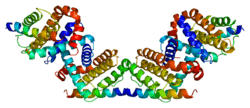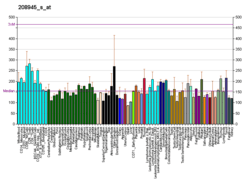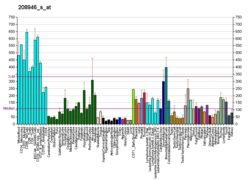BECN1
Beclin-1 is a protein that in humans is encoded by the BECN1 gene.[5][6] Beclin-1 is a mammalian ortholog of the yeast autophagy-related gene 6 (Atg6) and BEC-1 in the C. elegans nematode.[7] This protein interacts with either BCL-2 or PI3k class III, playing a critical role in the regulation of both autophagy and cell death.
Role in disease
Beclin-1 plays an important role in tumorigenesis, and neurodegeneration, being implicated in the autophagic programmed cell death.[8] Ovarian cancer with upregulated autophagy has a less aggressive behavior and is more responsive to chemotherapy.[9]
Schizophrenia is associated with low levels of Beclin-1 in the hippocampus of the affected which causes diminished autophagy which in turn results in increased neuronal cell death.[10]
Modulators
References
- GRCh38: Ensembl release 89: ENSG00000126581 - Ensembl, May 2017
- GRCm38: Ensembl release 89: ENSMUSG00000035086 - Ensembl, May 2017
- "Human PubMed Reference:". National Center for Biotechnology Information, U.S. National Library of Medicine.
- "Mouse PubMed Reference:". National Center for Biotechnology Information, U.S. National Library of Medicine.
- Liang XH, Kleeman LK, Jiang HH, Gordon G, Goldman JE, Berry G, et al. (November 1998). "Protection against fatal Sindbis virus encephalitis by beclin, a novel Bcl-2-interacting protein". Journal of Virology. 72 (11): 8586–96. doi:10.1128/JVI.72.11.8586-8596.1998. PMC 110269. PMID 9765397.
- "Entrez Gene: BECN1 beclin 1 (coiled-coil, myosin-like BCL2 interacting protein)".
- Takacs-Vellai K, Vellai T, Puoti A, Passannante M, Wicky C, Streit A, et al. (August 2005). "Inactivation of the autophagy gene bec-1 triggers apoptotic cell death in C. elegans". Current Biology. 15 (16): 1513–7. doi:10.1016/j.cub.2005.07.035. PMID 16111945.
- Zhong Y, Wang QJ, Li X, Yan Y, Backer JM, Chait BT, et al. (April 2009). "Distinct regulation of autophagic activity by Atg14L and Rubicon associated with Beclin 1-phosphatidylinositol-3-kinase complex". Nature Cell Biology. 11 (4): 468–76. doi:10.1038/ncb1854. PMC 2664389. PMID 19270693.
- Valente G, Morani F, Nicotra G, Fusco N, Peracchio C, Titone R, et al. (2014). "Expression and clinical significance of the autophagy proteins BECLIN 1 and LC3 in ovarian cancer". BioMed Research International. 2014: 462658. doi:10.1155/2014/462658. PMC 4127242. PMID 25136588.
- Merenlender-Wagner A, Malishkevich A, Shemer Z, Udawela M, Gibbons A, Scarr E, et al. (February 2015). "Autophagy has a key role in the pathophysiology of schizophrenia". Molecular Psychiatry. 20 (1): 126–32. doi:10.1038/mp.2013.174. PMC 4320293. PMID 24365867. Lay summary – MediLexicon International Ltd.
- Erlich S, Mizrachy L, Segev O, Lindenboim L, Zmira O, Adi-Harel S, et al. (2007). "Differential interactions between Beclin 1 and Bcl-2 family members". Autophagy. 3 (6): 561–8. doi:10.4161/auto.4713. PMID 17643073.
- Yue Z, Horton A, Bravin M, DeJager PL, Selimi F, Heintz N (August 2002). "A novel protein complex linking the delta 2 glutamate receptor and autophagy: implications for neurodegeneration in lurcher mice". Neuron. 35 (5): 921–33. doi:10.1016/S0896-6273(02)00861-9. PMID 12372286.
- Kara NZ, Toker L, Agam G, Anderson GW, Belmaker RH, Einat H (September 2013). "Trehalose induced antidepressant-like effects and autophagy enhancement in mice". Psychopharmacology. 229 (2): 367–75. doi:10.1007/s00213-013-3119-4. PMID 23644913.
Further reading
- Funderburk SF, Wang QJ, Yue Z (June 2010). "The Beclin 1-VPS34 complex--at the crossroads of autophagy and beyond". Trends in Cell Biology. 20 (6): 355–62. doi:10.1016/j.tcb.2010.03.002. PMC 3781210. PMID 20356743.
- Rommens JM, Durocher F, McArthur J, Tonin P, LeBlanc JF, Allen T, et al. (August 1995). "Generation of a transcription map at the HSD17B locus centromeric to BRCA1 at 17q21". Genomics. 28 (3): 530–42. doi:10.1006/geno.1995.1185. PMID 7490091.
- Maruyama K, Sugano S (January 1994). "Oligo-capping: a simple method to replace the cap structure of eukaryotic mRNAs with oligoribonucleotides". Gene. 138 (1–2): 171–4. doi:10.1016/0378-1119(94)90802-8. PMID 8125298.
- Suzuki Y, Yoshitomo-Nakagawa K, Maruyama K, Suyama A, Sugano S (October 1997). "Construction and characterization of a full length-enriched and a 5'-end-enriched cDNA library". Gene. 200 (1–2): 149–56. doi:10.1016/S0378-1119(97)00411-3. PMID 9373149.
- Aita VM, Liang XH, Murty VV, Pincus DL, Yu W, Cayanis E, et al. (July 1999). "Cloning and genomic organization of beclin 1, a candidate tumor suppressor gene on chromosome 17q21". Genomics. 59 (1): 59–65. doi:10.1006/geno.1999.5851. PMID 10395800.
- Liang XH, Jackson S, Seaman M, Brown K, Kempkes B, Hibshoosh H, Levine B (December 1999). "Induction of autophagy and inhibition of tumorigenesis by beclin 1". Nature. 402 (6762): 672–6. Bibcode:1999Natur.402..672L. doi:10.1038/45257. PMID 10604474.
- Kihara A, Kabeya Y, Ohsumi Y, Yoshimori T (April 2001). "Beclin-phosphatidylinositol 3-kinase complex functions at the trans-Golgi network". EMBO Reports. 2 (4): 330–5. doi:10.1093/embo-reports/kve061. PMC 1083858. PMID 11306555.
- Liang XH, Yu J, Brown K, Levine B (April 2001). "Beclin 1 contains a leucine-rich nuclear export signal that is required for its autophagy and tumor suppressor function". Cancer Research. 61 (8): 3443–9. PMID 11309306.
- Weinmann AS, Bartley SM, Zhang T, Zhang MQ, Farnham PJ (October 2001). "Use of chromatin immunoprecipitation to clone novel E2F target promoters". Molecular and Cellular Biology. 21 (20): 6820–32. doi:10.1128/MCB.21.20.6820-6832.2001. PMC 99859. PMID 11564866.
- Yue Z, Horton A, Bravin M, DeJager PL, Selimi F, Heintz N (August 2002). "A novel protein complex linking the delta 2 glutamate receptor and autophagy: implications for neurodegeneration in lurcher mice". Neuron. 35 (5): 921–33. doi:10.1016/S0896-6273(02)00861-9. PMID 12372286.
- Song H, Xia SL, Liao C, Li YL, Wang YF, Li TP, Zhao MJ (February 2004). "Genes encoding Pir51, Beclin 1, RbAp48 and aldolase b are up or down-regulated in human primary hepatocellular carcinoma". World Journal of Gastroenterology. 10 (4): 509–13. doi:10.3748/wjg.v10.i4.509. PMC 4716970. PMID 14966907.
- Scarlatti F, Bauvy C, Ventruti A, Sala G, Cluzeaud F, Vandewalle A, et al. (April 2004). "Ceramide-mediated macroautophagy involves inhibition of protein kinase B and up-regulation of beclin 1". The Journal of Biological Chemistry. 279 (18): 18384–91. doi:10.1074/jbc.M313561200. PMID 14970205.
- Furuya D, Tsuji N, Yagihashi A, Watanabe N (July 2005). "Beclin 1 augmented cis-diamminedichloroplatinum induced apoptosis via enhancing caspase-9 activity". Experimental Cell Research. 307 (1): 26–40. doi:10.1016/j.yexcr.2005.02.023. PMID 15922724.
- Kruse KB, Brodsky JL, McCracken AA (January 2006). "Characterization of an ERAD gene as VPS30/ATG6 reveals two alternative and functionally distinct protein quality control pathways: one for soluble Z variant of human alpha-1 proteinase inhibitor (A1PiZ) and another for aggregates of A1PiZ". Molecular Biology of the Cell. 17 (1): 203–12. doi:10.1091/mbc.E04-09-0779. PMC 1345659. PMID 16267277.
- Zeng X, Overmeyer JH, Maltese WA (January 2006). "Functional specificity of the mammalian Beclin-Vps34 PI 3-kinase complex in macroautophagy versus endocytosis and lysosomal enzyme trafficking". Journal of Cell Science. 119 (Pt 2): 259–70. doi:10.1242/jcs.02735. PMID 16390869.
- Shibata M, Lu T, Furuya T, Degterev A, Mizushima N, Yoshimori T, et al. (May 2006). "Regulation of intracellular accumulation of mutant Huntingtin by Beclin 1". The Journal of Biological Chemistry. 281 (20): 14474–85. doi:10.1074/jbc.M600364200. PMID 16522639.
- Lim J, Hao T, Shaw C, Patel AJ, Szabó G, Rual JF, et al. (May 2006). "A protein-protein interaction network for human inherited ataxias and disorders of Purkinje cell degeneration". Cell. 125 (4): 801–14. doi:10.1016/j.cell.2006.03.032. PMID 16713569.
- Daniel F, Legrand A, Pessayre D, Vadrot N, Descatoire V, Bernuau D (May 2006). "Partial Beclin 1 silencing aggravates doxorubicin- and Fas-induced apoptosis in HepG2 cells". World Journal of Gastroenterology. 12 (18): 2895–900. doi:10.3748/wjg.v12.i18.2895. PMC 4087807. PMID 16718815.
External links
- Human BECN1 genome location and BECN1 gene details page in the UCSC Genome Browser.
- Overview of all the structural information available in the PDB for UniProt: Q14457 (Beclin-1) at the PDBe-KB.







